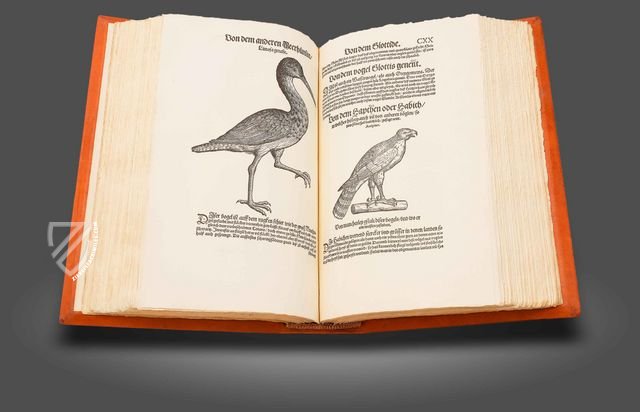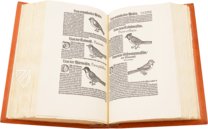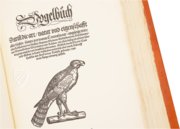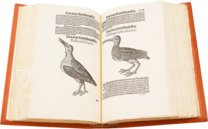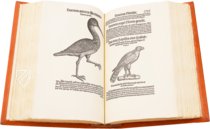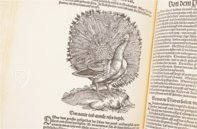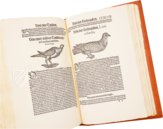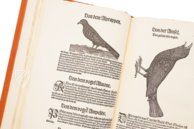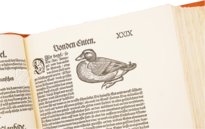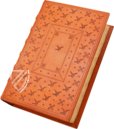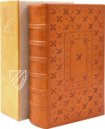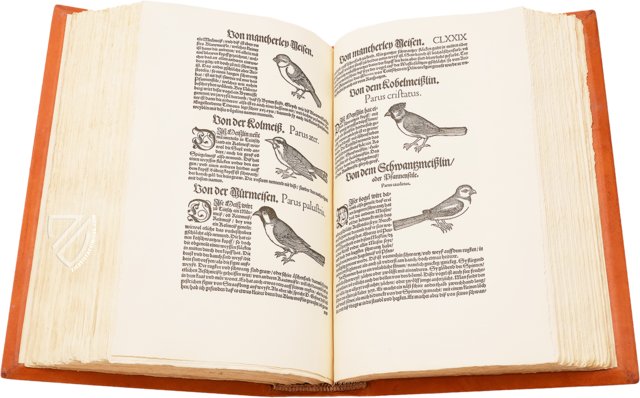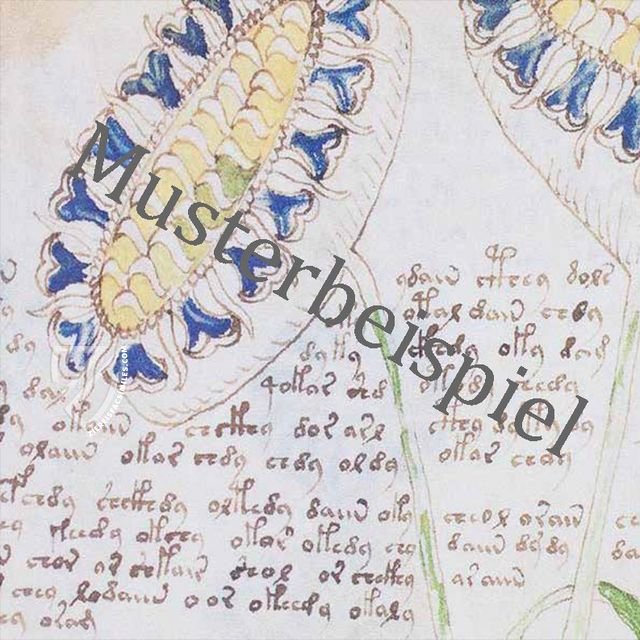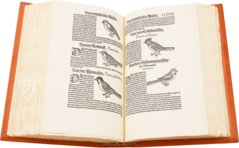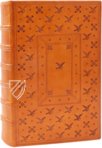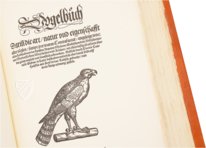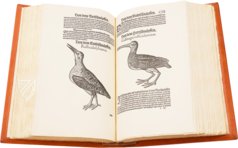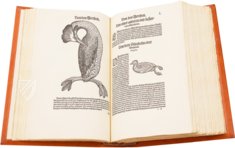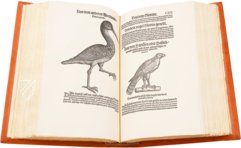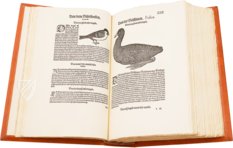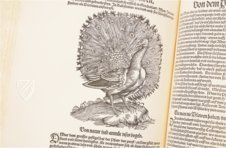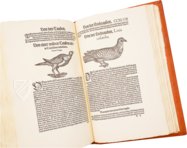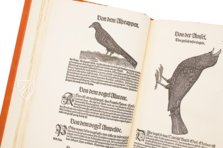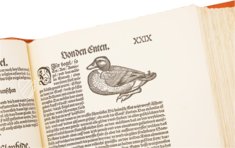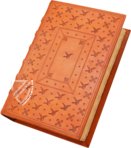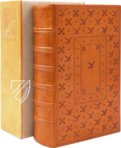Conrad Gessner: Vogelbuch
(3,000€ - 7,000€)
The Vogelbuch ( i.e. 'Bird Book') is the third volume of the influential opus magnum of the physician, naturalist and philologist Conrad Gessner (1516–1565): the Historia animalium. In this four-volume Latin compendium, published between 1551 and 1558, the humanist scholar brought together the entire zoological knowledge of his time, aided by his extensive contacts with many other European scholars. For both the text and the remarkable illustrations, he drew on existing works, which is why quite a few mythical creatures appear in the encyclopedia. At the same time, however, it also contains scientific observations and impressively realistic woodcuts, with which Gessner laid a foundation for modern zoology. The first German edition of the Vogelbuch was translated by Rudolf Hüsli (d. 1600) and published by Christoph Froschauer in Zurich in 1557. In this book all birds known at that time, but also other flying animals such as the bat, are comprehensively described in alphabetical order and illustrated by over 200 elaborate and in some cases full-page woodcuts.
Conrad Gessner: Vogelbuch
Conrad Gessner (1516–1565) was a Zurich physician, naturalist and philologist. After studying in Bourges and Paris, he worked as a teacher, professor of Greek language and natural history as well as a physician and continually supplemented his livelihood through scholarly writing. What began pragmatically soon became his passion: Until the end of his life, he pursued studies in natural history and even published a geological treatise in the year of his death – he died of the plague in 1565.
Gessner's Magnum Opus
With the Historia animalium, which was intended to bring together all the zoological knowledge of his time, Gessner not only created his personal magnum opus, but also became the founder of modern zoology, as he gave greater weight to his own observations of nature than to the traditional knowledge of antiquity and the Middle Ages in the four-volume work. However, these still form the basis of the Latin compendium. It is also a reflection of his philological interest: Gessner attached great importance to listing the individual names of the animal species in different languages and mentioning all vernacular variations of their names.
Historia Animalium
Gessner initially published the four extensive volumes on live-bearing quadrupeds (Quadrupedes vivipares), egg-laying quadrupeds (Quadrupedes ovipares), birds (Avium natura) and aquatic creatures (Piscium & aquatilium animantium natura) in Latin. They were published between 1551 and 1558 by Christoph Froschauer in Zurich. In 1587, a further posthumous publication of a fifth volume on snakes was released, which appeared in his estate.
Science and Fantasy
Even the first editions were illustrated with hundreds of woodcuts, which form an important part of the work. While he drew on existing works for most of the illustrations, such as the famous Rhinoceros by Albrecht Dürer or the giraffe from Bernhard von Breydenbach'sPeregrinatio in terram sanctam, he also made some woodcuts himself – 65 in number. Many of the illustrations are purely works of fantasy or were made on the vague basis of verbal descriptions. However, there are also some based on precise observations of nature, which was still an absolute novelty in the 16th century.
The Book of Birds
The entire work quickly became a zoological bestseller, which brought Gessner international fame. Rudolf Hüsli (d. 1600)** translated the third volume of the series into German just two years after its publication. This translation was first published in 1557, also by Christoph Froschauer in Zurich. Here too, the texts, which comprehensively describe all birds and flying animals known at the time in alphabetical order, are supplemented by elaborate woodcuts, some of which are astonishingly naturalistic and come in various sizes.
Codicology
- Alternative Titles
- Vogelbuch von Conrad Gessner
Vogelbuoch: darinn die Art, Natur und Eigenschafft aller Vöglen, sampt jrer waren Contrafactur angezeigt wirt
Vogelbuch. Faksimile nach der Ausgabe bei Froschauer, Zürich 1557.
Historia animalium
Avium natura - Size / Format
- 287 pages / 36.0 × 24.0 cm
- Origin
- Switzerland
- Date
- 1557
- Epochs
- Style
- Genre
- Language
- Illustrations
- More than 200 woodcuts + 1 title page
- Content
- Descriptions of 316 bird species
- Artist / School
- Conrad Gessner (author)
Rudolf Hüsli (translator)
Christoph Froschauer (printer/publisher)
Conrad Gessner: Vogelbuch
Peacock
This large woodcut shows the "most beautiful of all birds" - the peacock (Latin: Pauo), for which Hüsli uses the spelling "Pfaw", mentioning that elsewhere it is called "Pauw". Depicted is a male specimen standing sublimely on a small, grassy elevation with its tail feathers erect. The bird's extremely detailed and differentiated plumage is remarkable, consisting of the most diverse types of feathers - and without any coloration at all. Another striking detail is the animal's muscular chest, which makes it look all the more imposing.

Conrad Gessner: Vogelbuch
Great Crested Grebe
This almost full-page woodcut probably shows a Great Crested Grebe, which Gessner still lists as Colymbus maior and for whose genus he finds various vernacular terms: Dücchel, Fluder, and Merchen. The large bird appears strangely staged in the image. The head is bent backwards as if for feather grooming, while the feet stick out to the sides. At the same time, the plumage, especially of the wing, is executed in great detail.
These indications suggest that the woodcut was made from the model of a dead specimen of the species, which was brought into the depicted posture for this purpose – a not uncommon method of animal study in the early modern period. This was certainly possible, as Gessner reports in the accompanying text that the Great Crested Grebe occurs in many Swiss lakes and was traditionally caught with nets in the Greifensee on "Düccheltag" in August.
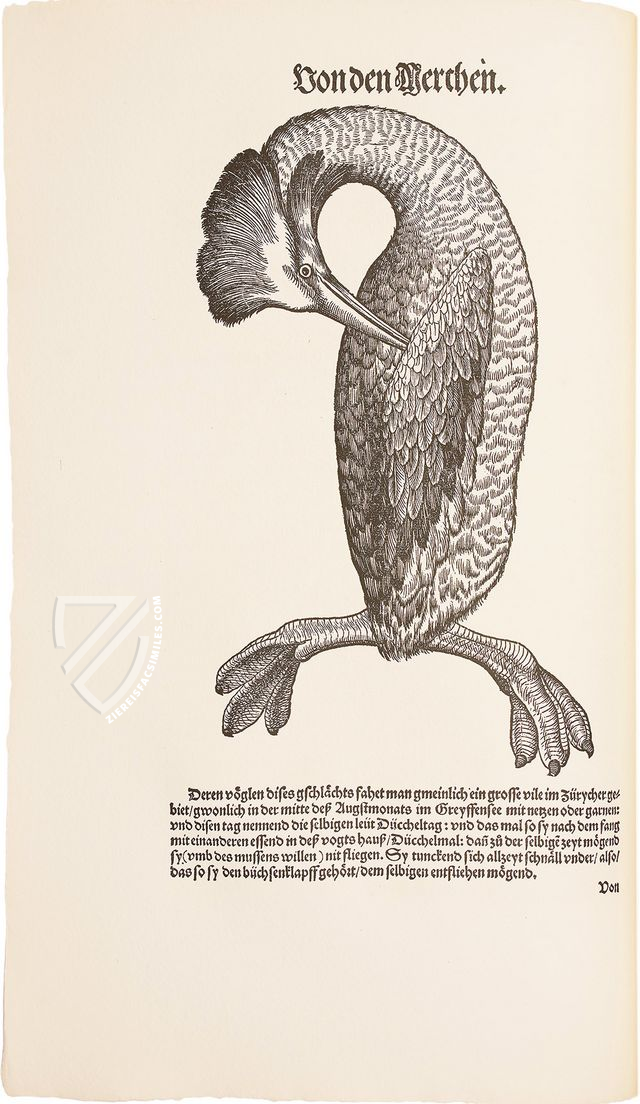
#1 Vogelbuch. Faksimile nach der Ausgabe bei Froschauer, Zürich 1557. (Luxury Edition)
Language: German
The commentary volume (enclosed) includes a synoptic index of Gessner's Latin and German bird names and their modern scientific synonyms.
(3,000€ - 7,000€)
#2 Vogelbuch. Faksimile nach der Ausgabe bei Froschauer, Zürich 1557. (Standard Edition)
(1,000€ - 3,000€)
- Treatises / Secular Books
- Apocalypses / Beatus
- Astronomy / Astrology
- Bestiaries
- Bibles / Gospels
- Chronicles / History / Law
- Geography / Maps
- Saints' Lives
- Islam / Oriental
- Judaism / Hebrew
- Single Leaf Collections
- Leonardo da Vinci
- Literature / Poetry
- Liturgical Manuscripts
- Medicine / Botany / Alchemy
- Music
- Mythology / Prophecies
- Psalters
- Other Religious Books
- Games / Hunting
- Private Devotion Books
- Other Genres
- Afghanistan
- Armenia
- Austria
- Belgium
- Colombia
- Croatia
- Cyprus
- Czech Republic
- Denmark
- Egypt
- Ethiopia
- France
- Germany
- Greece
- Hungary
- India
- Iran
- Iraq
- Israel
- Italy
- Japan
- Lebanon
- Luxembourg
- Mexico
- Morocco
- Netherlands
- Palestine
- Peru
- Poland
- Portugal
- Russia
- Serbia
- Spain
- Sri Lanka
- Sweden
- Switzerland
- Syria
- Turkey
- Ukraine
- United Kingdom
- United States
- Uzbekistan
- Aboca Museum
- Ajuntament de Valencia
- Akademie Verlag
- Akademische Druck- u. Verlagsanstalt (ADEVA)
- Aldo Ausilio Editore - Bottega d’Erasmo
- Alecto Historical Editions
- Alkuin Verlag
- Almqvist & Wiksell
- Amilcare Pizzi
- Andreas & Andreas Verlagsbuchhandlung
- Archa 90
- Archiv Verlag
- Archivi Edizioni
- Arnold Verlag
- ARS
- Ars Magna
- ArtCodex
- AyN Ediciones
- Azimuth Editions
- Badenia Verlag
- Bärenreiter-Verlag
- Belser Verlag
- Belser Verlag / WK Wertkontor
- Benziger Verlag
- Bernardinum Wydawnictwo
- BiblioGemma
- Biblioteca Apostolica Vaticana (Vaticanstadt, Vaticanstadt)
- Bibliotheca Palatina Faksimile Verlag
- Bibliotheca Rara
- Boydell & Brewer
- Bramante Edizioni
- Bredius Genootschap
- Brepols Publishers
- British Library
- C. Weckesser
- Caixa Catalunya
- Canesi
- CAPSA, Ars Scriptoria
- Caratzas Brothers, Publishers
- Carus Verlag
- Casamassima Libri
- Chavane Verlag
- Christian Brandstätter Verlag
- Circulo Cientifico
- Club Bibliófilo Versol
- Club du Livre
- CM Editores
- Collegium Graphicum
- Collezione Apocrifa Da Vinci
- Comissão Nacional para as Comemorações dos Descobrimentos Portugueses
- Coron Verlag
- Corvina
- CTHS
- D. S. Brewer
- Damon
- De Agostini/UTET
- De Nederlandsche Boekhandel
- De Schutter
- Deuschle & Stemmle
- Deutscher Verlag für Kunstwissenschaft
- DIAMM
- Droz
- E. Schreiber Graphische Kunstanstalten
- Ediciones Boreal
- Ediciones Grial
- Ediclube
- Edições Inapa
- Edilan
- Editalia
- Edition Deuschle
- Edition Georg Popp
- Edition Leipzig
- Edition Libri Illustri
- Editiones Reales Sitios S. L.
- Éditions de l'Oiseau Lyre
- Editions Medicina Rara
- Editorial Casariego
- Editorial Mintzoa
- Editrice Antenore
- Editrice Velar
- Edizioni Edison
- Egeria, S.L.
- Eikon Editores
- Electa
- Emery Walker Limited
- Enciclopèdia Catalana
- Eos-Verlag
- Ephesus Publishing
- Ernst Battenberg
- Eugrammia Press
- Extraordinary Editions
- Fackelverlag
- Facsimila Art & Edition
- Facsimile Editions Ltd.
- Facsimilia Art & Edition Ebert KG
- Faksimile Verlag
- Feuermann Verlag
- Folger Shakespeare Library
- Franco Cosimo Panini Editore
- Friedrich Wittig Verlag
- Fundación Hullera Vasco-Leonesa
- G. Braziller
- Gabriele Mazzotta Editore
- Gebr. Mann Verlag
- Gesellschaft für graphische Industrie
- Getty Research Institute
- Giovanni Domenico de Rossi
- Giunti Editore
- Graffiti
- Grafica European Center of Fine Arts
- Guido Pressler
- Guillermo Blazquez
- Gustav Kiepenheuer
- H. N. Abrams
- Harrassowitz
- Helikon
- Hendrickson Publishers
- Henning Oppermann
- Herder Verlag
- Hes & De Graaf Publishers
- Hoepli
- Holbein-Verlag
- Hortus Deliciarum
- Houghton Library
- Hugo Schmidt Verlag
- Idion Verlag
- Il Bulino, edizioni d'arte
- ILte
- Imago
- Insel Verlag
- Instituto Nacional de Antropología e Historia
- Istituto dell'Enciclopedia Italiana - Treccani
- Istituto Ellenico di Studi Bizantini e Postbizantini
- Istituto Geografico De Agostini
- Istituto Poligrafico e Zecca dello Stato
- Italarte Art Establishments
- J. Thorbecke
- Jan Thorbecke Verlag
- Johnson Reprint Corporation
- Josef Stocker
- Josef Stocker-Schmid
- Jugoslavija
- Karl W. Hiersemann
- Kasper Straube
- Kaydeda Ediciones
- Kindler Verlag / Coron Verlag
- Kodansha International Ltd.
- Konrad Kölbl Verlag
- Kurt Wolff Verlag
- La Liberia dello Stato
- La Linea Editrice
- La Meta Editore
- Lambert Schneider
- Landeskreditbank Baden-Württemberg
- Leo S. Olschki
- Les Incunables
- Library of Congress
- Libreria Musicale Italiana
- Lichtdruck
- Lito Immagine Editore
- Lumen Artis
- Lund Humphries
- M. Moleiro Editor
- Maison des Sciences de l'homme et de la société de Poitiers
- Manuscriptum
- Martinus Nijhoff
- Maruzen-Yushodo Co. Ltd.
- MASA
- McGraw-Hill
- Militos
- Millennium Liber
- Müller & Schindler
- Nahar and Steimatzky
- National Library of Wales
- Neri Pozza
- Nova Charta
- Oceanum Verlag
- Odeon
- Orbis Mediaevalis
- Orbis Pictus
- Österreichische Staatsdruckerei
- Oxford University Press
- Pageant Books
- Parzellers Buchverlag
- Patrimonio Ediciones
- Pattloch Verlag
- PIAF
- Pieper Verlag
- Plon-Nourrit et cie
- Prestel Verlag
- Princeton University Press
- Prisma Verlag
- Priuli & Verlucca, editori
- Pro Sport Verlag
- Propyläen Verlag
- Pytheas Books
- Quaternio Verlag Luzern
- Reales Sitios
- Recht-Verlag
- Reichert Verlag
- Reichsdruckerei
- Riehn & Reusch
- Roberto Vattori Editore
- Rosenkilde and Bagger
- Roxburghe Club
- Salerno Editrice
- Sarajevo Svjetlost
- Schöck ArtPrint Kft.
- Scolar Press
- Scrinium
- Scripta Maneant
- Scriptorium
- Siloé, arte y bibliofilia
- SISMEL - Edizioni del Galluzzo
- Sociedad Mexicana de Antropología
- Société des Bibliophiles & Iconophiles de Belgique
- Soncin Publishing
- Sorli Ediciones
- Stainer and Bell
- Studer
- Styria Verlag
- Sumptibus Pragopress
- Szegedi Tudomànyegyetem
- Taberna Libraria
- Tarshish Books
- Taschen
- Tempus Libri
- Testimonio Compañía Editorial
- Thames and Hudson
- The Clear Vue Publishing Partnership Limited
- The Facsimile Codex
- The Folio Society
- The Marquess of Normanby
- The Richard III and Yorkist History Trust
- Tip.Le.Co
- TouchArt
- TREC Publishing House
- TRI Publishing Co.
- Trident Editore
- Typis Regiae Officinae Polygraphicae
- Union Verlag Berlin
- Universidad de Granada
- University of California Press
- University of Chicago Press
- Urs Graf
- Vallecchi
- Van Wijnen
- VCH, Acta Humaniora
- VDI Verlag
- VEB Deutscher Verlag für Musik
- Verlag Anton Pustet / Andreas Verlag
- Verlag Bibliophile Drucke Josef Stocker
- Verlag der Münchner Drucke
- Verlag für Regionalgeschichte
- Verlag Styria
- Vicent Garcia Editores
- W. Turnowsky
- Waanders Printers
- Wiener Mechitharisten-Congregation (Wien, Österreich)
- Wissenschaftliche Buchgesellschaft
- Wydawnictwo Dolnoslaskie
- Xuntanza Editorial
- Zakład Narodowy
- Zollikofer AG

